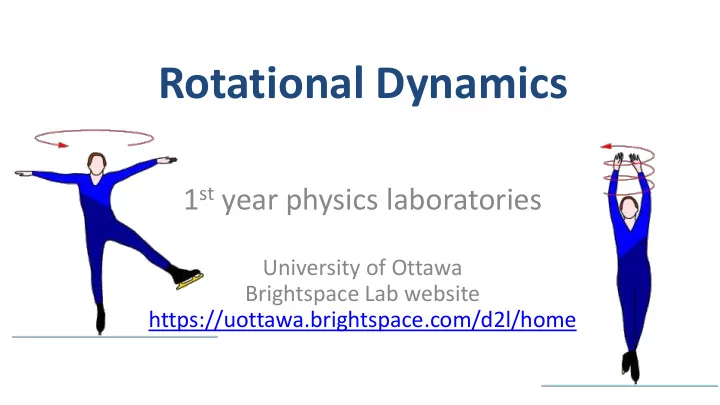

Rotational Dynamics 1 st year physics laboratories University of Ottawa Brightspace Lab website https://uottawa.brightspace.com/d2l/home
INTRODUCTION • Newtonian dynamics tells us that net force is proportional to acceleration F = ma . • For an object that is free to rotate, consider the rotational analogue: τ = I α torque = moment of inertia × angular acceleration • The moment of inertia for a cylinder is given by: I = MR 2 / 2 where M and R are the mass and the radius of the cylinder.
INTRODUCTION (part 1) • We can experimentally determine the moment of inertia of an object by applying a known torque and measuring the angular acceleration. • You will apply a series of torques to a disc and measure corresponding angular accelerations. – You will make a plot to graphically determine the moment of inertia.
INTRODUCTION (part 1 cont.) • The rotational sensor measures θ vs t. • You will measure angular accelerations for different torques – Angular speed: ω = d θ / dt – Angular acceleration: α = d ω / dt • We use a hanging mass so torque is: τ = rT ( T is tension) • For the acceleration of the hanging mass: mg – T = ma - We solve for T : τ = rT = mr ( g – a ) = mr ( g – α r ) ( a is acceleration of mass)
INTRODUCTION (part 2) • Similar to the linear momentum experiment, you will investigate how the angular momentum of a rotating system is affected by a change in the moment of inertia. • You will measure the angular speed of a rotating disc before ( ω ) and after ( ωˊ ) a completely inelastic collision. • The equation to calculate the angular momentum before and after the collision is: L = I 1 ω = Lˊ = I 1 ωˊ + I 2 ωˊ
OBJECTIVES • Part 1: Collect α for various τ (three objects) Experimentally determine I for an object • Part 2: Measure ω before and after a collision to see how a change in I affects L .
PART 1 – Moment of Inertia • Record the diameter of the large pulley and the mass and diameter of the first aluminum disc. • Attach a string to the edge of the large pulley on the sensor and hang it over the green pulley. Attach the mass hanger to the end of the string. – Make sure the mass hanger is close to but not touching the ground. • Wind the large pulley and collect data (5 s) as the mass hanger accelerates the aluminum disc. • To determine the angular acceleration of the disc, perform a linear fit on the ω vs t graph. • Repeat the measurement for increasing masses.
The setup for rotating discs
A Closer Look…
PART 1 – Moment of Inertia (cont.) • Find the mass of the second aluminum disc (the one with cork padding). • Repeat the experiment with both aluminum discs attached to the sensor. • Find the masses of the rod and weights then attach them to the sensor. • Repeat the experiment for the rod and weights (use 20 s collection).
The setup for rotating rod and masses
PART 1 – Moment of Inertia (cont.) • You will make a plot of τ vs α for the three data sets you collected. • Perform a linear regression on each data set to determine your experimental values for the moments of inertia of the three systems. • Recall our formula that relates τ and α . τ = mr ( g – α r )
PART 2 – Conversation of Angular Momentum • Mount your first aluminum disc to the pulley (same as first section of Part 1). • Spin the first disc. You’ll notice the velocity decreasing gradually. • Position the second disc over the screw and practice dropping it onto the first. • Collect the angular velocity data of the system before ( ω ) and after ( ωˊ ) the collision. – Using your graph of ω vs t , calculate whether the total momentum of the system was conserved.
CLEAN UP DUE DATE The report is due at the end • Turn off the computer , and don’t forget to of the lab session. take your USB key. Make sure you submit your • Put the discs, rod, and weights on the graphs in Brightspace before leaving! table. • Please recycle scrap paper and throw away any garbage. Please leave your station as clean as you can. • Push back the monitor, keyboard, and mouse. Please push your chair back under the table. • Thank you!
Recommend
More recommend